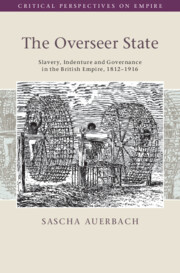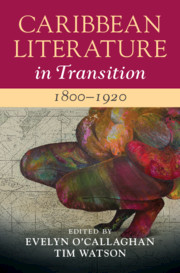Refine search
Actions for selected content:
21 results
Chapter 9 - Sugar
- from Part III - Applications
-
-
- Book:
- Commodities and Literature
- Published online:
- 14 October 2025
- Print publication:
- 09 October 2025, pp 163-178
-
- Chapter
- Export citation
7 - “They Have Made the Government Arbitrary Enough”
-
- Book:
- The Overseer State
- Published online:
- 21 March 2025
- Print publication:
- 27 March 2025, pp 281-323
-
- Chapter
- Export citation
4 - “A System Entirely Favorable to the Poorer Class of Natives”
-
- Book:
- The Overseer State
- Published online:
- 21 March 2025
- Print publication:
- 27 March 2025, pp 148-183
-
- Chapter
- Export citation
3 - “A Most Imperfect Act of Abolition”
-
- Book:
- The Overseer State
- Published online:
- 21 March 2025
- Print publication:
- 27 March 2025, pp 107-147
-
- Chapter
- Export citation
2 - “To Go and Look for Law”
-
- Book:
- The Overseer State
- Published online:
- 21 March 2025
- Print publication:
- 27 March 2025, pp 69-106
-
- Chapter
- Export citation

The Overseer State
- Slavery, Indenture and Governance in the British Empire, 1812–1916
-
- Published online:
- 21 March 2025
- Print publication:
- 27 March 2025
5 - An Empire of Free Trade?
- from II - 1819–85: Becoming Liberal and Global
-
- Book:
- Modern Britain, 1750 to the Present
- Published online:
- 14 January 2025
- Print publication:
- 30 January 2025, pp 148-189
-
- Chapter
- Export citation
3 - Laboring Bodies
- from Part I - Extraction and Abstraction
-
-
- Book:
- The Cambridge Companion to the Black Body in American Literature
- Published online:
- 09 May 2024
- Print publication:
- 16 May 2024, pp 49-61
-
- Chapter
- Export citation
4 - Entangling Labor Migration in the Americas, 1840–1940
- from Part I - Problematizing Freedom and Mobility
-
-
- Book:
- The Cambridge History of Global Migrations
- Published online:
- 12 May 2023
- Print publication:
- 01 June 2023, pp 104-120
-
- Chapter
- Export citation
2 - The History of South Asian Global Migration
- from Part I - Problematizing Freedom and Mobility
-
-
- Book:
- The Cambridge History of Global Migrations
- Published online:
- 12 May 2023
- Print publication:
- 01 June 2023, pp 67-85
-
- Chapter
- Export citation
Antislavery, “Native Labour,” and the Turn to Indenture in British Colonial Natal, 1842–1860
-
- Journal:
- Comparative Studies in Society and History / Volume 65 / Issue 3 / July 2023
- Published online by Cambridge University Press:
- 19 April 2023, pp. 500-525
-
- Article
-
- You have access
- Open access
- HTML
- Export citation
Chapter 10 - Slavery and Indenture in the Literatures of the Indian Ocean World
- from Part III - Legacies and Afterlives
-
-
- Book:
- The Cambridge Companion to Global Literature and Slavery
- Published online:
- 15 December 2022
- Print publication:
- 22 December 2022, pp 164-184
-
- Chapter
- Export citation
The privilege of the Indian passport (1947–1967): Caste, class, and the afterlives of indenture in Indian diplomacy
-
- Journal:
- Modern Asian Studies / Volume 57 / Issue 2 / March 2023
- Published online by Cambridge University Press:
- 11 July 2022, pp. 321-350
- Print publication:
- March 2023
-
- Article
-
- You have access
- Open access
- HTML
- Export citation
5 - Examining Indenture Trustee Duties
- from Part I - Identifying Fiduciaries and Their Duties
-
-
- Book:
- Fiduciary Obligations in Business
- Published online:
- 20 August 2021
- Print publication:
- 09 September 2021, pp 93-110
-
- Chapter
- Export citation
2 - India in Global Human Circulations
-
- Book:
- India and the World
- Published online:
- 19 March 2021
- Print publication:
- 25 March 2021, pp 51-85
-
- Chapter
- Export citation
Chapter 14 - Caribbean Literature as Diasporic Archive
- from Part III - The Caribbean Region in Transition
-
-
- Book:
- Caribbean Literature in Transition, 1800–1920
- Published online:
- 16 December 2020
- Print publication:
- 14 January 2021, pp 231-246
-
- Chapter
- Export citation
Chapter 17 - South Asian Migration and Settlement Stories, 1800–1920
- from Part III - The Caribbean Region in Transition
-
-
- Book:
- Caribbean Literature in Transition, 1800–1920
- Published online:
- 16 December 2020
- Print publication:
- 14 January 2021, pp 278-293
-
- Chapter
- Export citation
Introduction
-
-
- Book:
- Caribbean Literature in Transition, 1800–1920
- Published online:
- 16 December 2020
- Print publication:
- 14 January 2021, pp 1-14
-
- Chapter
- Export citation

Caribbean Literature in Transition, 1800–1920
-
- Published online:
- 16 December 2020
- Print publication:
- 14 January 2021
2 - Global Contexts: How External Factors Drive US Perceptions of Slavery
-
- Book:
- American Slavery, American Imperialism
- Published online:
- 17 August 2020
- Print publication:
- 30 July 2020, pp 67-106
-
- Chapter
- Export citation
